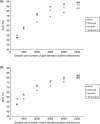Training set expansion: an approach to improving the reconstruction of biological networks from limited and uneven reliable interactions
- PMID: 19015141
- PMCID: PMC2639005
- DOI: 10.1093/bioinformatics/btn602
Training set expansion: an approach to improving the reconstruction of biological networks from limited and uneven reliable interactions
Abstract
Motivation: An important problem in systems biology is reconstructing complete networks of interactions between biological objects by extrapolating from a few known interactions as examples. While there are many computational techniques proposed for this network reconstruction task, their accuracy is consistently limited by the small number of high-confidence examples, and the uneven distribution of these examples across the potential interaction space, with some objects having many known interactions and others few.
Results: To address this issue, we propose two computational methods based on the concept of training set expansion. They work particularly effectively in conjunction with kernel approaches, which are a popular class of approaches for fusing together many disparate types of features. Both our methods are based on semi-supervised learning and involve augmenting the limited number of gold-standard training instances with carefully chosen and highly confident auxiliary examples. The first method, prediction propagation, propagates highly confident predictions of one local model to another as the auxiliary examples, thus learning from information-rich regions of the training network to help predict the information-poor regions. The second method, kernel initialization, takes the most similar and most dissimilar objects of each object in a global kernel as the auxiliary examples. Using several sets of experimentally verified protein-protein interactions from yeast, we show that training set expansion gives a measurable performance gain over a number of representative, state-of-the-art network reconstruction methods, and it can correctly identify some interactions that are ranked low by other methods due to the lack of training examples of the involved proteins.
Figures




Similar articles
-
Semi-supervised multi-task learning for predicting interactions between HIV-1 and human proteins.Bioinformatics. 2010 Sep 15;26(18):i645-52. doi: 10.1093/bioinformatics/btq394. Bioinformatics. 2010. PMID: 20823334 Free PMC article.
-
A semi-supervised learning approach to predict synthetic genetic interactions by combining functional and topological properties of functional gene network.BMC Bioinformatics. 2010 Jun 24;11:343. doi: 10.1186/1471-2105-11-343. BMC Bioinformatics. 2010. PMID: 20573270 Free PMC article.
-
Kernel methods for predicting protein-protein interactions.Bioinformatics. 2005 Jun;21 Suppl 1:i38-46. doi: 10.1093/bioinformatics/bti1016. Bioinformatics. 2005. PMID: 15961482
-
Prediction and integration of regulatory and protein-protein interactions.Methods Mol Biol. 2009;541:101-43. doi: 10.1007/978-1-59745-243-4_6. Methods Mol Biol. 2009. PMID: 19381527 Review.
-
Effects of functional bias on supervised learning of a gene network model.Methods Mol Biol. 2009;541:463-75. doi: 10.1007/978-1-59745-243-4_20. Methods Mol Biol. 2009. PMID: 19381535 Review.
Cited by
-
Network clustering: probing biological heterogeneity by sparse graphical models.Bioinformatics. 2011 Apr 1;27(7):994-1000. doi: 10.1093/bioinformatics/btr070. Epub 2011 Feb 10. Bioinformatics. 2011. PMID: 21317141 Free PMC article.
-
Automated Detection of Acute Myocardial Infarction Using Asynchronous Electrocardiogram Signals-Preview of Implementing Artificial Intelligence With Multichannel Electrocardiographs Obtained From Smartwatches: Retrospective Study.J Med Internet Res. 2021 Sep 10;23(9):e31129. doi: 10.2196/31129. J Med Internet Res. 2021. PMID: 34505839 Free PMC article.
-
Triangle network motifs predict complexes by complementing high-error interactomes with structural information.BMC Bioinformatics. 2009 Jun 27;10:196. doi: 10.1186/1471-2105-10-196. BMC Bioinformatics. 2009. PMID: 19558694 Free PMC article.
-
Rising Strengths Hong Kong SAR in Bioinformatics.Interdiscip Sci. 2017 Jun;9(2):224-236. doi: 10.1007/s12539-016-0147-x. Epub 2016 Mar 9. Interdiscip Sci. 2017. PMID: 26961385 Free PMC article. Review.
-
Semi-supervised multi-task learning for predicting interactions between HIV-1 and human proteins.Bioinformatics. 2010 Sep 15;26(18):i645-52. doi: 10.1093/bioinformatics/btq394. Bioinformatics. 2010. PMID: 20823334 Free PMC article.
References
-
- Aizerman M, et al. Theoretical foundations of the potential function method in pattern recognition learning. Automat. Rem. Contr. 1964;25:821–837.
-
- Ben-Hur A, Noble WS. Kernel methods for predicting protein-protein interactions. Bioinformatics. 2005;21(Suppl. 1):i38–i46. - PubMed
-
- Bleakley K, et al. Supervised reconstruction of biological networks with local models. Bioinformatics. 2007;23:i57–i65. - PubMed
-
- Blum A, Mitchell T. The Eleventh Annual Workshop on Computational Learning Theory. Vol. 92. San Francisco, California, USA: Morgan Kaufmann Publishers; 1998. Combining labeled and unlabeled data with co-training. 100 pp.
-
- Chang C-C, Lin C-J. LIBSVM: a library for support vector machine. 2008. [(last accessed date on October 2008)]. Available at http://www.csie.ntu.edu.tw/~cjlin/papers/libsvm.pdf.
Publication types
MeSH terms
LinkOut - more resources
Full Text Sources
Molecular Biology Databases

